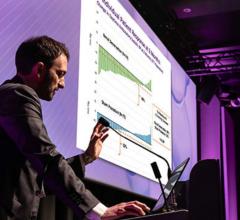
Late-breaking clinical data presented at EuroPCR 2023 in Paris demonstrated Elixir Medical’s DynamX Bioadaptor restores vessel motion and function with better effectiveness at 12 months compared to a leading drug-eluting stent (DES). Image courtesy: Elixir Medical Corporation
May 17, 2023 — Elixir Medical has reported that important data were presented at a late-breaking clinical session during the EuroPCR 2023 conference in Paris. In its May 17 statement, the cardiovascular technology company reported that the large international randomized BIOADAPTOR RCT trial — of the company’s DynamX Coronary Drug-Eluting Bioadaptor compared to Resolute Onyx Drug-Eluting Stent — met its primary endpoint of Target Lesion Failure (TLF) non-inferiority at 12 months.
DynamX Bioadaptor is a new type of coronary implant designed to unlock the scaffold, uncage the vessel, to return normal vessel motion and function after percutaneous coronary intervention (PCI), with continued dynamic support of the atherosclerotic vessel to reduce long-term adverse events. In the study, the bioadaptor demonstrated superior effectiveness of its unique mechanism of action across secondary intravascular imaging endpoints, achieving restoration of the vessel motion and function compared to persistent constraint with DES.
The novel bioadaptor scaffold achieved a very low 1.8% TLF rate compared to 2.8% for Resolute Onyx DES (p<0.001), as well as similar acute performance, acute lumen gain, and percent diameter stenosis at baseline. And, for the first time seen in a coronary revascularization implant, the bioadaptor scaffold demonstrated normal pulsatility in the device treated segment, confirming restoration of vessel function at 12 months.
“It is widely believed that caging the vessel by stents has limited the field from overcoming the suboptimal efficacy and safety events,” said Shigeru Saito, M.D., principal investigator and director of the Division of Cardiology and Catheterization Laboratory at Shonan Kamakura General Hospital in Kamakura, Japan. Saito added: “The DynamX Bioadaptor exceeded our expectations against a good DES in clinical outcomes, and for the first time ever demonstrated restoration of vessel pulsatility, motion and function by uncaging the vessel. These findings establish that the bioadaptor addresses the shortcomings of DES and bioresorbable scaffolds, and collectively point to a technology effectiveness standard not seen before. The finding of plaque changes is very exciting, pointing to a new effect and potential benefit of restoring vessel function.”
Clinical Trial Details
The BIOADAPTOR RCT Trial is an international, single-blinded, randomized controlled (1:1) trial comparing a sirolimus-eluting Bioadaptor with a contemporary zotarolimus-eluting stent in 445 patients. Both arms had large randomized multi-imaging modality subgroups of 100 patients powered to document standard stent effectiveness benchmarks, and the new effectiveness benchmarks of vessel motion and function. Data collection will continue through five years. The BIOADAPTOR RCT trial is the third trial of Elixir Medical’s robust DynamX Bioadaptor clinical evidence program consisting of nine company sponsored and investigator-initiated studies involving over 9,000 patients, including INFINITY SWEDEHEART RCT (n=2400) and a global BIO-RESTORE registry with a target enrollment of up to 5,000 patients.
On Clinical Safety and Efficacy, the results included that the study’s primary endpoint was met. The DynamX Bioadaptor was non-inferior to Resolute Onyx DES in target lesion failure (TLF) at 12 months (1.8% vs. 2.8%, p <0.001), a 35% difference. In addition, across components of TLF, there were no cardiac deaths in the DynamX arm, and very low rates of target vessel myocardial infarction, and target lesion revascularization in both arms.
Device Effectiveness and Vessel Function Results were as follows: Restored vessel pulsatility – Lumen area changes during cardiac cycle were measured with stationary intravascular ultrasound (IVUS) at multiple sections along the length of the devices and adjacent non-treated vessel segments. At 12 months, the DynamX in-device lumen area showed ability to significantly increase compared to post-implant and expand by 7.5% between systole and diastole cardiac cycles, at a rate similar to non-treated segments of the vessel, while DES continued to be constrained due to caging.
Additionally, DynamX Bioadaptor was significantly more effective at maintaining an open lumen at 12 months compared to DES with percent diameter stenosis (%DS) at 12.7% vs. 17.3% (p=0.05) and late lumen loss (LLL) being significantly lower at 0.09mm vs. 0.25mm for DynamX and Resolute Onyx, respectively (p=.038). These measures were also lower across key vessel and lesion subsets of LAD, long lesions (≥23mm) and small vessels (≤2.75mm). Similar trend in low LLL was observed across vessel and lesion subsets in patients with diabetes.
A novel finding of plaque stabilization and regression was described in this manner: In a post-hoc analysis of the 100-patient IVUS cohort, the DynamX arm showed only a 3% change in in-device plaque volume (original lesion plaque treated by PCI) while the DES arm showed a significantly higher 12% increase (p=0.032). Over 90% of the patients in both study arms were on lipid lowering medication for secondary prevention. When lesions were analyzed for plaque composition those that had higher content of lipids showed a regression of -9% in plaque volume with DynamX compared to an increase of +10% with DES (p=.0008), pointing to a hypothesis of a synergistic effect between restoration of vessel motion and function with DynamX and systemic use of lipid-lowering medications.
"For many years, Elixir persevered to develop breakthrough technologies to elevate PCI treatment effectiveness for patients worldwide,” said Motasim Sirhan, CEO of Elixir Medical. Sirhan also said, “Development of the DynamX Bioadaptor — the first coronary scaffold technology designed to unlock, uncage the vessel, and restore and sustain normal vessel motion and function — has been a multi-year journey, and today we are humbled to report results that elevate PCI treatment effectiveness.” He further reinforced the company’s commitment to continuing to build clinical evidence and developing breakthrough technologies to advance PCI outcomes, and to enable treatment of vulnerable plaque, and chronic angina patients.
A privately-held company based in Milpitas, California, Elixir Medical Corporation develops disruptive platforms to treat coronary and peripheral artery disease, whose technologies have multiple applications across the cardiovascular and peripheral space designed to deliver improved clinical outcomes for millions of patients. The DynamX Coronary Bioadaptor System is CE-marked.; not available for sale in the USA.
More information: www.elixirmedical.com
Find more EuroPCR 2023 coverage here
Related content:
DynamX Bioadaptor Restores Rotational Motion and Vessel Stress Reduction in New Study


 May 30, 2024
May 30, 2024 


